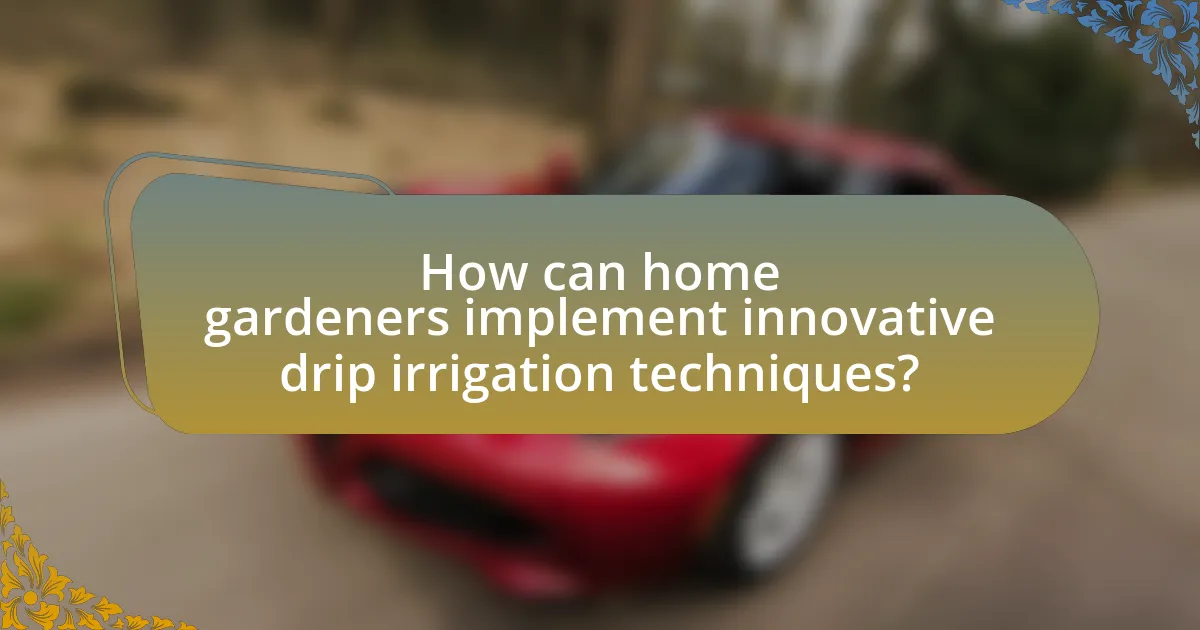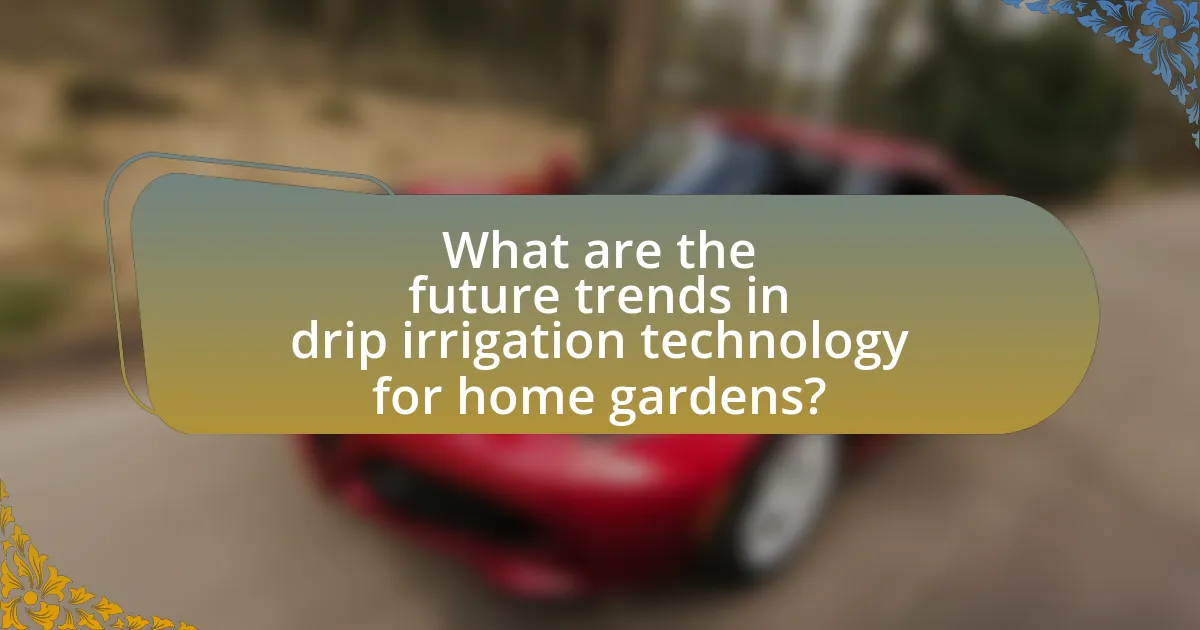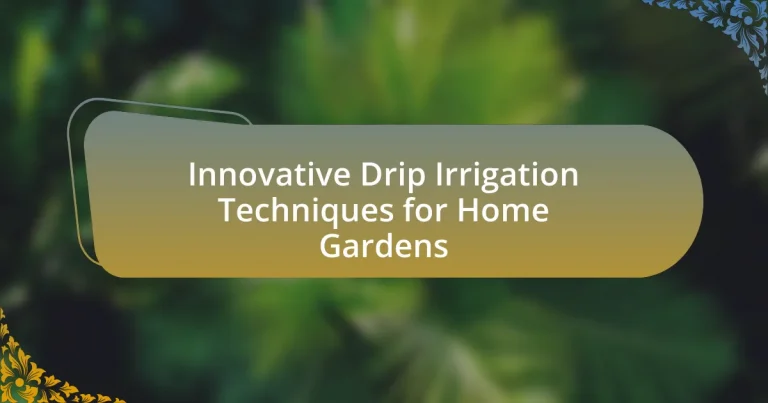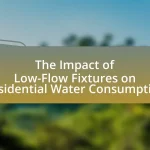Innovative drip irrigation techniques for home gardens focus on enhancing water efficiency and promoting healthier plant growth through advanced methods such as smart irrigation systems, subsurface drip irrigation, and rainwater harvesting. These techniques significantly reduce water consumption by up to 50% compared to traditional irrigation methods by delivering water directly to the root zone, minimizing evaporation and runoff. Key components of these systems include drip emitters, tubing, and sensors that optimize water delivery based on real-time soil moisture levels. The article also addresses common mistakes to avoid, maintenance best practices, and future trends in drip irrigation technology, providing practical insights for home gardeners looking to implement these sustainable practices.

What are Innovative Drip Irrigation Techniques for Home Gardens?
Innovative drip irrigation techniques for home gardens include the use of smart irrigation systems, which utilize sensors and timers to optimize water usage based on soil moisture levels and weather conditions. These systems can reduce water consumption by up to 50% compared to traditional methods. Another technique is the implementation of subsurface drip irrigation, where tubing is buried beneath the soil surface, delivering water directly to the root zone, minimizing evaporation and runoff. Additionally, rainwater harvesting systems can be integrated with drip irrigation to utilize collected rainwater, further enhancing sustainability and reducing reliance on municipal water sources. These methods not only improve water efficiency but also promote healthier plant growth by providing consistent moisture levels.
How do these techniques differ from traditional irrigation methods?
Innovative drip irrigation techniques differ from traditional irrigation methods primarily in their efficiency and precision of water delivery. While traditional methods often involve surface irrigation that can lead to significant water loss through evaporation and runoff, innovative drip irrigation systems deliver water directly to the plant roots, minimizing waste and ensuring that plants receive the exact amount of moisture needed. This targeted approach can reduce water usage by up to 50% compared to conventional methods, as evidenced by studies showing that drip irrigation can improve water conservation and crop yield in home gardens.
What are the key features of innovative drip irrigation systems?
Innovative drip irrigation systems are characterized by precision water delivery, efficiency in resource use, and advanced technology integration. These systems utilize emitters that release water directly to the plant roots, minimizing evaporation and runoff, which can lead to water savings of up to 50% compared to traditional irrigation methods. Additionally, many innovative systems incorporate smart technology, such as soil moisture sensors and automated timers, allowing for real-time adjustments based on environmental conditions. This technology not only enhances water efficiency but also promotes healthier plant growth by ensuring optimal moisture levels. Furthermore, modular designs enable easy customization and scalability, making these systems suitable for various garden sizes and layouts.
Why are these techniques becoming popular among home gardeners?
Innovative drip irrigation techniques are becoming popular among home gardeners due to their efficiency in water usage and ability to promote healthier plant growth. These techniques minimize water waste by delivering water directly to the root zone, which can reduce water consumption by up to 50% compared to traditional irrigation methods. Additionally, they help prevent overwatering and reduce the risk of fungal diseases, leading to stronger and more resilient plants. The growing awareness of sustainable gardening practices and the need for water conservation in many regions further contribute to the increasing adoption of these methods among home gardeners.
What are the main components of innovative drip irrigation systems?
The main components of innovative drip irrigation systems include drip emitters, tubing, filters, pressure regulators, and connectors. Drip emitters deliver water directly to the plant roots, ensuring efficient water usage. Tubing serves as the main conduit for water transport, while filters prevent clogging by removing debris and particles. Pressure regulators maintain optimal water pressure for consistent flow, and connectors facilitate the assembly of the system. These components work together to enhance water efficiency and promote healthy plant growth in home gardens.
How do emitters function in drip irrigation?
Emitters in drip irrigation function by delivering a controlled amount of water directly to the root zone of plants. These devices regulate water flow through small openings, allowing for precise application and minimizing evaporation and runoff. Emitters can be pressure-compensating or non-pressure-compensating, with the former maintaining a consistent flow rate regardless of pressure changes in the system. This functionality is crucial for efficient water use, as studies show that drip irrigation can reduce water usage by up to 60% compared to traditional irrigation methods, while also improving crop yields.
What role do hoses and tubing play in these systems?
Hoses and tubing are essential components in drip irrigation systems, as they transport water directly to the plant roots efficiently. These elements ensure precise water delivery, minimizing evaporation and runoff, which is crucial for conserving water in home gardens. Research indicates that using hoses and tubing in drip irrigation can reduce water usage by up to 50% compared to traditional watering methods, highlighting their effectiveness in promoting sustainable gardening practices.
What benefits do innovative drip irrigation techniques provide for home gardens?
Innovative drip irrigation techniques provide efficient water usage and improved plant health for home gardens. These systems deliver water directly to the root zone of plants, minimizing evaporation and runoff, which can lead to water savings of up to 50% compared to traditional irrigation methods. Additionally, by supplying water consistently and at optimal levels, these techniques promote healthier root development and reduce the risk of overwatering, which can cause root rot and other plant diseases. Studies have shown that gardens utilizing drip irrigation can yield higher crop production due to better moisture management and nutrient absorption.
How do these techniques conserve water compared to other methods?
Innovative drip irrigation techniques conserve water more effectively than traditional methods by delivering water directly to the plant roots, minimizing evaporation and runoff. Unlike conventional irrigation systems that often spray water over a wide area, drip irrigation targets specific plants, ensuring that water is used efficiently. Studies indicate that drip irrigation can reduce water usage by 30-50% compared to surface irrigation methods, which can lead to significant water savings in home gardens.
What impact do they have on plant health and growth?
Innovative drip irrigation techniques significantly enhance plant health and growth by delivering water directly to the root zone, minimizing water wastage and ensuring optimal moisture levels. This targeted approach reduces the risk of overwatering and under-watering, which can lead to root rot or drought stress. Studies have shown that plants receiving water through drip irrigation exhibit improved nutrient uptake and overall vigor, resulting in higher yields and better quality produce. For instance, research published in the Journal of Irrigation and Drainage Engineering indicates that crops irrigated with drip systems can achieve yield increases of up to 30% compared to traditional irrigation methods.

How can home gardeners implement innovative drip irrigation techniques?
Home gardeners can implement innovative drip irrigation techniques by utilizing smart irrigation systems that incorporate sensors and timers to optimize water usage. These systems can monitor soil moisture levels and weather conditions, ensuring that plants receive the right amount of water at the right time, which can reduce water waste by up to 50% compared to traditional methods. Additionally, gardeners can use drip tape or tubing with emitters placed directly at the plant roots, allowing for targeted watering that minimizes evaporation and runoff. This method not only conserves water but also promotes healthier plant growth by delivering moisture directly where it is needed.
What steps are involved in setting up a drip irrigation system?
To set up a drip irrigation system, follow these steps: first, plan the layout by determining the areas to be irrigated and the type of plants involved. Next, gather necessary materials such as drip tubing, emitters, connectors, and a water source. After that, install the mainline tubing along the planned layout, ensuring it is securely placed. Then, attach the emitters at appropriate intervals based on plant needs. Following this, connect the system to the water source and test for leaks and proper water flow. Finally, adjust the emitters as needed to ensure even distribution of water. These steps are essential for effective water management in home gardens, promoting plant health and conserving water.
What tools and materials are necessary for installation?
For the installation of innovative drip irrigation systems in home gardens, essential tools and materials include a drip irrigation kit, which typically contains drip tubing, emitters, connectors, and stakes. Additionally, a shovel or spade is necessary for digging trenches, while a pair of scissors or a tubing cutter is required for cutting the tubing to the desired lengths. A pressure regulator is also important to ensure optimal water flow, and a filter is needed to prevent clogging of the emitters. These components are crucial for creating an efficient and effective drip irrigation system that conserves water and promotes healthy plant growth.
How can gardeners customize their systems for different plant types?
Gardeners can customize their irrigation systems for different plant types by adjusting the flow rate, emitter size, and placement of drip lines. For instance, plants with high water needs, such as tomatoes, benefit from larger emitters that deliver more water, while drought-tolerant plants, like succulents, require smaller emitters to prevent overwatering. Additionally, varying the spacing of drip lines allows for tailored water distribution based on the root zones of specific plants, ensuring optimal moisture levels. This approach is supported by research indicating that customized irrigation can improve plant health and water efficiency, as demonstrated in studies on precision agriculture techniques.
What common mistakes should be avoided when using drip irrigation?
Common mistakes to avoid when using drip irrigation include improper system design, inadequate water pressure, and neglecting regular maintenance. Improper system design can lead to uneven water distribution, which affects plant health; for instance, spacing emitters too far apart can result in dry spots. Inadequate water pressure may prevent emitters from functioning correctly, leading to insufficient watering. Regular maintenance, such as checking for clogs and leaks, is essential; failure to do so can reduce system efficiency by up to 50%, as reported by the University of California Agriculture and Natural Resources.
How can improper installation affect system performance?
Improper installation can significantly degrade the performance of a drip irrigation system. When components such as emitters, tubing, and connectors are not correctly positioned or secured, it can lead to uneven water distribution, resulting in some plants receiving too much water while others receive too little. This imbalance can cause plant stress, reduced growth, and even plant death. Additionally, leaks from poorly installed connections can waste water and increase operational costs. Studies indicate that proper installation can improve water efficiency by up to 30%, highlighting the importance of correct setup for optimal system performance.
What are the signs of a malfunctioning drip irrigation system?
Signs of a malfunctioning drip irrigation system include uneven water distribution, visible leaks, clogged emitters, and reduced water pressure. Uneven water distribution can lead to some plants receiving too much water while others receive too little, indicating potential blockages or system failures. Visible leaks often occur at connection points or damaged tubing, which can waste water and reduce efficiency. Clogged emitters, caused by sediment or mineral buildup, prevent proper water flow, affecting plant health. Lastly, reduced water pressure may signal a larger issue within the system, such as a broken line or pump failure. These signs collectively indicate that the drip irrigation system requires immediate attention to ensure optimal performance and plant health.

What are the future trends in drip irrigation technology for home gardens?
Future trends in drip irrigation technology for home gardens include the integration of smart technology, such as soil moisture sensors and automated systems, which enhance water efficiency and plant health. These advancements allow for real-time monitoring and adjustments based on environmental conditions, leading to reduced water waste and optimized growth. Additionally, the use of biodegradable materials for drip lines is gaining traction, promoting sustainability and reducing plastic waste in gardening. Research indicates that these innovations can improve water conservation by up to 30%, making them increasingly attractive for home gardeners seeking eco-friendly solutions.
How is technology advancing drip irrigation systems?
Technology is advancing drip irrigation systems through the integration of smart sensors and automation. These advancements allow for real-time monitoring of soil moisture levels, enabling precise water application tailored to the specific needs of plants. For instance, systems equipped with soil moisture sensors can automatically adjust water delivery based on current conditions, reducing water waste by up to 50% compared to traditional methods. Additionally, mobile applications provide users with the ability to control and schedule irrigation remotely, enhancing efficiency and convenience. This technological evolution not only optimizes water usage but also promotes healthier plant growth by ensuring consistent moisture levels.
What role do smart irrigation controllers play in modern systems?
Smart irrigation controllers optimize water usage in modern irrigation systems by automating the scheduling and operation of watering based on real-time environmental data. These controllers utilize sensors and weather data to adjust watering schedules, ensuring that plants receive the appropriate amount of water while minimizing waste. For instance, studies have shown that smart irrigation systems can reduce water usage by up to 30% compared to traditional methods, demonstrating their effectiveness in promoting water conservation and enhancing plant health.
How can sensors improve the efficiency of drip irrigation?
Sensors can improve the efficiency of drip irrigation by providing real-time data on soil moisture levels, enabling precise water application. This technology allows for the optimization of water usage, reducing waste and ensuring that plants receive the exact amount of water needed for growth. For instance, studies have shown that using soil moisture sensors can lead to water savings of up to 30% compared to traditional irrigation methods, as they prevent overwatering and promote healthier root systems.
What are the best practices for maintaining a drip irrigation system?
The best practices for maintaining a drip irrigation system include regular inspection, cleaning filters, checking for leaks, and adjusting emitters. Regular inspection ensures that all components function properly, while cleaning filters prevents clogging, which can disrupt water flow. Checking for leaks helps maintain efficiency and conserves water, and adjusting emitters according to plant needs optimizes water delivery. Research indicates that proper maintenance can improve system efficiency by up to 30%, demonstrating the importance of these practices in maximizing the effectiveness of drip irrigation systems.
How often should systems be checked for clogs and leaks?
Drip irrigation systems should be checked for clogs and leaks at least once a month during the growing season. Regular monthly inspections help identify issues early, ensuring optimal water delivery and preventing plant stress. Research indicates that consistent monitoring can reduce water waste by up to 30%, highlighting the importance of these checks in maintaining system efficiency and plant health.
What seasonal adjustments should be made for optimal performance?
For optimal performance in innovative drip irrigation techniques for home gardens, seasonal adjustments should include modifying the irrigation schedule based on plant growth stages and local climate conditions. During warmer months, increase the frequency and duration of watering to accommodate higher evaporation rates and plant water needs, while in cooler months, reduce watering to prevent over-saturation and root rot. Research indicates that adjusting irrigation based on seasonal weather patterns can improve water efficiency by up to 30%, as demonstrated in studies conducted by the University of California Cooperative Extension.
What practical tips can enhance the effectiveness of drip irrigation in home gardens?
To enhance the effectiveness of drip irrigation in home gardens, ensure proper system design and maintenance. A well-designed system includes correctly spaced emitters that deliver water directly to the root zones of plants, minimizing evaporation and runoff. Regularly check for clogs in the emitters and clean or replace them as needed to maintain optimal water flow. Additionally, using mulch around plants can help retain soil moisture and reduce the frequency of irrigation. Research indicates that gardens utilizing these practices can achieve up to 30% water savings compared to traditional irrigation methods, demonstrating the efficiency of drip irrigation when properly implemented.


